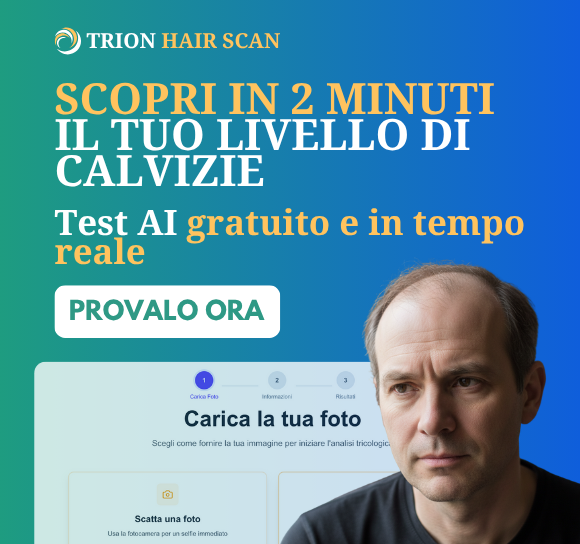Natrecia ? Un integratore naturale per trattare Alopecia Androgenetica e Ipertrofia Prostatica Benigna
Natrecia is a food supplement composed of minerals, vitamins and herbs. Its intended use is for hair health and maintenance. It can also be used for treatment of benign prostatic hyperplasia (BPH), the swelling of the prostate in middle-aged men. Natrecia will benefit both men and women. People who use Natrecia can also use our topical hair maintenance product, Crinagen. The components of Natrecia are: (per tablet)
Saw Palmetto Berries Extract 400 mg; Beta Sitosterol 200 mg; Rye Pollen Extract 100 mg; Pumpkin Seed Extract 100 mg; Lycopene 50 mg; Zinc 20 mg; Copper 1 mg; Vitamin B6 (pyridoxal-5-phosphate) 10 mg; Phosphorus (as phosphate) 100 mg; Calcium 125 mg.
Natrecia is a completely natural, vitamin, mineral, and herbal supplement specifically developed for combating the effects of androgenic alopecia (AP) (i.e., male-pattern baldness). Its formulation is based on a significant body of research that firmly establishes the effect that certain natural agents have in combating the effects of dihydrotestosterone (DHT) in the treatment of benign prostatic hyperplasia (BPH).
This essay begins with a detailed discussion of the prostate gland because prostatic disease has a similar hormonal etiology to androgenic alopecia (male pattern hair loss). Both conditions are caused, in part, by the male sex hormone dihydrotestosterone (DHT). Most importantly, both conditions are preventable.
PROSTATE DISEASE
The prostate is a gland located beneath the urinary bladder in men. It is responsible for the production of fluids involved in reproduction. When men urinate, the urine that is stored in the bladder must travel through a conduit, called the urethra, before it can exit the penis. The urethra passes through the prostate after exiting the bladder. This is because in addition to carrying urine, the urethra is also responsible for carrying the reproductive fluids that are produced in the prostate. As a consequence of its location, an enlarged prostate can contribute to urinary flow obstruction as well as to bladder dysfunction by “squeezing” on the urethra. This can result in the various urinary symptoms associated with an enlarged prostate, such as frequent urination during the day, frequent urination at night, dribbling, having a weak urinary stream, urgency, and incomplete emptying of the bladder. It can also result in the inability to urinate altogether.
The medical term for a non-cancerous enlarged prostate is benign prostatic hyperplasia. The somewhat similar term, benign prostatic hypertrophy, is commonly used. Again, this condition is thought to result, in part, from exposure to specific androgens, such as dihydrotestosterone. Autopsy results reveal that virtually all men who live past a certain age develop this condition. Individuals born with a deficiency in 5-alpha reductase, the enzyme that produces dihydrotestosterone, suffer neither hair loss nor prostatic disease. People who lack this enzyme are unable to produce the more potent form of testosterone, dihydrotestosterone. Again, dihydrotestosterone (DHT) is required for the development of both androgenic alopecia (male pattern hair loss) and prostatic disease (BPH).
TREATMENT
There are two basic treatment options for an enlarged prostate gland or benign prostatic hyperplasia. These include medical (drugs) and surgical therapy. When men with benign prostatic hyperplasia, a condition many physicians believe to be caused by excess dihydrotestosterone, were treated with oral or systemic finasteride (the generic name of Propecia and Proscar), their enlarged prostate glands became smaller [1]. Unfortunately, this study also revealed that a small percentage of the patients (less than 6%) receiving this drug also suffered from sexually related side effects such as decreased sex drive and impotence [1]. Surgical therapy can also lead to sexually related side effects.
Recently, medical literature has provided increased support for the use of naturally occurring nutrients that prevent the progressive enlargement of the prostate gland (BPH). Some of these nutrients have even been shown to reduce the incidence of prostate cancer! The nutrients that combat the detrimental effects of DHT in the prostate can be utilized to combat the effects of DHT in hair loss. The following discussion outlines multiple DHT-fighting agents. Each of these agents is included in Natrecia.
SAW PALMETTO
This is by far the most commonly recognized and discussed herb concerning the prostate. Before we even begin its discussion, I highly recommend reading the book entitled “Saw Palmetto: Nature’s Prostate Healer” by Ray Sahelian, M.D. This is a marvelous book that discusses the prostate and how Saw palmetto and other natural nutrients can prevent prostate disease (BPH).
Saw palmetto is a plant (dwarf palm tree) native to the United States. It has been used medicinally for over a century. Its first use was described in the medical literature in the 1800s. Early literature concerning Saw palmetto stated that it relieved symptoms ranging from prostate enlargement in men to gynecological problems in women, such as menstrual discomfort. It has even been described as a potential aphrodisiac.
Saw palmetto contains hundreds of different substances that can account for its beneficial effects. Saw palmetto is usually distributed as a crushed berry or as an extract. The extract form contains most of the substances found to be effective in treating benign prostatic enlargement. The extract form has been shown to be more potent than the dried berry form. The extract, then, is the form of choice.
There are many articles in the medical literature that establish the efficacy of Saw palmetto in treating benign prostatic hyperplasia. One of the most recent and prestigious articles is “Saw Palmetto Extracts for the Treatment of Benign Prostatic Hyperplasia: a Systematic Review” by Timothy J. Wilt, MD, MPH et al. It appeared in The Journal of the American Medical Association on November 11, 1998 [2]. The study clearly demonstrated that the use of Saw palmetto improved urinary tract symptoms associated with benign prostatic hyperplasia. It also demonstrated that Saw palmetto provided similar improvement in urinary tract symptoms when compared to drugs such as finasteride. Saw palmetto was associated with fewer side effects. Although the mean study duration (the period of time that participants were using Saw palmetto) was 9 weeks, participants were noticing positive results in as little as 4 weeks. Finasteride users commonly saw relief of symptoms after three months.
The next three paragraphs are a bit technical, but some readers may appreciate the detail. Others may wish to skip ahead to the paragraph that begins, ?It is clear that?.?
A total of 18 randomized controlled trials involving 2939 men who met inclusion criteria were analyzed. Treatment allocation concealment was adequate in 9 studies (i.e., they were single-blind tests), whereas 16 studies were double-blinded. The average duration of the study was 9 weeks. In comparison to the men in the placebo control group, men treated with the SP extract Serenoa repens (S. repens or Saw palmetto) showed a measurable improvement in urinary tract symptoms. The weighted average difference for patients treated with S. repens was -1.41 points with a 95% confidence interval of L2.52, -0.301, compared to the control group’s weighted-mean difference of -0.76 with a 95% confidence interval of [-1.22, -0.32]. This represents a relative weighted mean difference of 46% (Here, a lower weighted-mean difference correlates with improved urinary tract function). The patients themselves provided self-improvement ratings in urinary tract symptoms that were highly correlated with their quantitative evaluations.
Compared with men receiving finasteride, men treated with S. repens showed similar improvements in urinary tract scores. The main advantage of treatment of BPH with S. repens over finasteride was apparent in the decreased incidence of adverse side effects. For example, 4.9% of patients treated with finasteride reported erectile dysfunction compared with 1.1% of patients treated with S. repens. These percentages are based on the Neyman-Pearson binary hypothesis test with power function parameter P set to P<0.001. That is, the probability of a Type-II error was fixed at 0.999. Here, a Type-II error refers to the probability of accepting the null hypothesis H_0 (no urinary tract improvement) when the alternative hypothesis H_1 (urinary tract improvement) is actually true. The significance level for all randomized trials was set at 0.05, thus indicating a probability of 0.05 of rejecting H_0 when H_1 is true.
Some key points regarding these results are in order here. First, since all the statistical studies are based on classical (or frequentist) methods, all inferences derived from them are inherently indirect. That is, no direct claims can be made regarding the probabilities of improved urinary tract function. Rather, one can only infer the probabilities that the treatment did not fail. This is by no means a fallacy, neither on the part of the researchers nor on the methods of data acquisition, but is an inherent aspect of frequentist analysis. To emphasize this point further, consider the value of the mean-weighted difference for patients treated with S. repens. The reported value was -1.41. Note that this is not a true statistical estimate of this parameter. Rather, it is a measured value that has a 95% probability of being contained in the random interval [2.52,-0.30]. If one wished to make direct inferences from the data, non-classical statistical analyses, such as those based on Bayesian decision theory, should be employed [3]. Another point worth mentioning concerns the sensitivities of the tests. Since the studies did not report the standard errors of the differences between the means of S. repens and control, the authors assessed the sensitivity of the tests by analyzing data for three different values of correlation coefficients, namely (0.25, 0.50, 0.75). The work, then, reported “no significant statistical difference in outcomes according to the three correlation coefficients.” As a result, the correlation coefficient was arbitrarily set to 0.50. One could certainly argue that this is a somewhat ad-hoc approach. To be more precise and more objective, the correlation coefficient could have (and should have) been estimated by a standard technique such as the method of maximum likelihood [4] or via another point estimator such as the Bayesian minimum mean square error (MMSE) estimator or even the Bayesian maximum a-posteriori (MAP) estimator [5]. This would certainly have altered the calculated relative weighted mean difference from its reported value of 46%, but to what degree is unknown. Note that the relative weighted mean difference of 46% was not actually reported in the JAMA article [1] but rather was calculated by the current authors based on the results in [1].
It is clear that there was an improvement in patients given Saw palmetto over the placebo-control group, and, moreover, the improved urinary tract function paralleled that which was displayed by patients taking finasteride. This study clearly demonstrated that the use of Saw palmetto improved urinary tract symptoms associated with BPH, and that its effects were in concert with the improvements achieved through the use of finasteride. It was also shown that, compared to finasteride, Saw palmetto administration produced a lower incidence of adverse side effects. The mean duration of the study encompassed 9 weeks of Saw palmetto administration. However, many participants were reporting positive results in as little as 4 weeks.
Both Saw palmetto and finasteride were found to be effective in the treatment of benign prostatic hyperplasia (BPH). This study clearly establishes the role of Saw palmetto in combating the effects of DHT. Note that Saw palmetto was compared to 5 mg of finasteride in this study and that Propecia contains only 1 mg of finasteride.
Side effects experienced with Saw palmetto are infrequent. One three-year study with 315 patients showed that 98% of the patient population had no significant side effects [6]. The most common side effects experienced with Saw palmetto include nausea and mild headache. Since Saw palmetto is fat-soluble, it is better to take it with meals. It usually takes one to two hours to be absorbed.
References (relating to Saw palmetto):
1. Gormley GJ, et al. The effect of finasteride in men with benign prostatic hyperplasia. N Engl J Med;327:1185-1191,1992.
2. T.J. Wilt, A. Ishani, G. Stark, R. MacDonald, J. Lau, and C. Muirow. Saw Palmetto extracts for treatment of benign prostatic hyperplasia. JAMA;280(18)1604-1609, 1998.
3. J. O’Berger, Statistical Decision Theory and Bayesian Analysis, 2nd Ed., Springer Verlag Series in Statistics, Springer,1985.
4. PJ. Bickel and K.A. Doksum, Mathematical Statistics — Basic Ideas and Selected Topics, Prentice Hall, Englewood Cliffs, NJ, 1977.
5. A. O’Hagan, Kendall’s Advanced Theory of Statistics, Volume 2B: Bayesian Inference, Halsted Press, New York, 1994.
6. D. Authie and J. Cauquil. A multicenter study of the efficacy of Permixon in daily practice. Pharmacol Clin; 5(56):3-13, 1987.
Suggested Reading: For the section above and all sections below, there is excellent reading in this book: Sahelian, R.; Saw Palmetto: Nature’s Prostate Healer; New York; Kensington Publishing Company, 1998.
PYGEUM AFRICANUM
Pygeum africanum is an evergreen tree indigenous to Africa. Extracts from its bark have been shown to improve urinary tract symptoms associated with benign prostatic hyperplasia [1]. Another study showed that, in addition to improving symptoms associated with BPH, this herb also improved sexual behavior in men [2]. Although its exact mechanism is unknown, many researchers speculate that it may work by inhibiting growth factors responsible for the increase in prostate size. Another theory is that this herb may have anti-inflammatory activity in the prostate gland itself.
References (relating to Pygeum africanum):
1. Barlet A, et al. Efficacy of Pygeum africanum extract in the medical therapy of urination disorders due to benign prostatic hyperplasia: evaluation of objective and subjective parameters. A placebo-controlled double-blind multicenter study. Wien Klin Wocheschr 102:667-673, 1990.
2. Carani C, et al. Urological and sexual evaluation in the treatment of benign prostatic disease using Pygeum Africanum at high doses. Arch Ital Urol Nefrol Androl 63:341-345, 1991.
BETA-SITOSTEROL
Beta-sitosterol is a plant-derived sterol found in Saw palmetto and Pygeum Africanum. Studies have shown that the use of beta-sitosterol has improved urinary tract symptoms associated with benign prostatic hyperplasia [1]. In addition, beta-sitosterol inhibits the proliferation of cancer cells in vitro [2].
References (related to beta-sitosterol):
1. Berges RR, Windeler J, Trampisch HJ, Senge T. Randomized, placebo-controlled, double blind clinical trials of beta-sitosterol in patients with benign prostatic hyperplasia. Beta-sitosterol Study Group. Lancet. 345: 1529-1532, 1995.
2. Awad AB, Chen YC, Fink CS, Hemmessey T. Beta-sitosterol inhibits HT-29 human colon cancer cell growth and alters membrane lipids. Anticancer Res 16:2797-2804, 1996.
STINGING NETTLE(estratto di radice di ortica)
Stinging nettle (Urtica dioica) is another herb indigenous to the United States. This herb has been utilized in Germany for treating both BPH and rheumatoid arthritis. Stinging nettle has been studied in combination with both Saw palmetto and Pygeum africanum in the treatment of BPH. When used with Saw palmetto, improvement in prostate-related urinary problems was documented [1]. When combined with Pygeum africanum, this herb diminished the symptoms of BPH. Researchers believe that this herb’s effectiveness is due to its affect on the delivery of hormones to the prostate gland.
References (related to stinging nettle):
1. Schneider HJ, Honold E, Masuhr T. Treatment of benign prostatic hyperplasia: Results of a treatment of Sabal extract WS 1473 and Urtica extract WS 1031 in urologic specialty practices. Fortschr Med 113:37-40, 1995.
RYE POLLEN EXTRACT
Rye pollen extract does not contain pollen or other allergens. Rye pollen extract has been shown to be effective in the treatment of BPH [1,2]. Its action is to inhibit the growth of prostate cells [3]. The substance in rye pollen extract that inhibits the growth of prostate cells also inhibits the growth of prostate cancer cells [4].
References (related to rye pollen extract):
1. Yasumoto R, et al. Clinical evaluation of long-term treatment using cernitin pollen extract in patients with benign prostatic hyperplasia. Clin Ther 17:82-87, 1995.
2. Dutkiewiccz S. Usefulness of Cenilton in the treatment of benign prostatic hyperplasia. Int Urol Nephrol 28:49-53, 1996.
3. Habib FK, et al. Identification of a prostate inhibitory substance in a pollen extract. Prostate 26(3):133-139,1995.
4. Zhang X, et al. Isolation and characterization of a cyclic hydroxamic acid from a pollen extract, which inhibits cancerous cell growth in vitro. J Med Chem 38:735-738, 1995.
PUMPKIN SEED EXTRACT (olio di semi di zucca)
Pumpkin seed extract is currently used in Germany for the treatment of BPH. Animal studies have confirmed its usefulness in the treatment of BPH [1]. Studies on the effects of pumpkin seed oil in combination with Saw palmetto have been conducted, but no studies determining the effects of pumpkin seed oil alone on BPH have been conducted in men.
References (related to pumpkin seed extract):
1. Zhang X, Ouyang JZ, Zhang YS, Tayalla B, Zhou XC, Zhou SW. Effect of the extracts of pumpkin seeds on the urodynamic of rabbits: an experimental study. J Tongji Med Univ, 14(4):235-238, 1994.
LYCOPENE
Although lycopene has nothing to do with promoting hair growth, it has been included in Natrecia. Many men will use Natrecia for prostate health (as well as for hair health). Lycopene is a powerful anti-carcinogen.
Lycopene is a pigmented substance found in tomatoes and other fruits and vegetables. Its antioxidant effects may be protective against prostate cancer. As a carotenoid, it has many vital health-promoting properties. The carotenoids include beta-carotene, alpha-carotene, lutein, and beta-cryptoxanthin. Among the common carotenoids, lycopene is the most efficient free-radical scavenger [1,2]. This property will be discussed in greater detail shortly. In addition, it is the predominant carotenoid found in plasma and in the prostate gland [3,4,5,6].
In a recent article published by the Journal of the National Cancer Institute, lycopene was shown to be the only carotenoid to significantly lower the risk of prostate cancer [7]. In the study, the primary sources of lycopene were tomato-based. Another beneficial source of lycopene is strawberries. The lycopene in tomato sauce, however, was most effective. The higher the intake of cooked tomato products, the lower the prostate cancer rate. This is probably because tomato sauce is prepared by cooking ripe tomatoes in an oil-based medium. This causes lycopene to be placed in a “micellar” suspension (i.e., within oily droplets) that is easily absorbed by the body. This is important because lycopene is highly lipophilic (fat-soluble) and its intestinal absorption is dependent on this “micellar” suspension. This preparation has been shown to enhance the absorption of lycopene [8]. This same study revealed a two to threefold increase in plasma concentrations of lycopene after ingestion of tomato sauce. In fact, in the study mentioned above, ingestion of tomato sauce was the major predictor of plasma lycopene levels [7].
Other studies have shown an inverse relationship between lycopene ingestion and prostate cancer [9,10]. (?Inverse’ means: as one factor is increased, another factor decreases.) Lycopene probably protects against prostate cancer by inhibiting the oxidation caused by free radical production. Free radicals are formed in our bodies when certain fat molecules react with oxygen. Free radical formation has been associated with arthritis, hardening of the arteries, and the development of cancer. Because it is an effective antioxidant, lycopene is thought to exert protective effects against prostate cancer. It also happens to be the most abundant carotenoid in the prostate and is twice as effective as beta-carotene. Lycopene ingestion has also been shown to lower the risk of digestive tract cancers.
References (related to lycopene):
1. Di Mascio P, Kaiser S, Sies H. Lycopene as the most efficient biological carotenoid singlet oxygen quencher. Arch Biochem Biophys 1989; 274: 532-8.
2. Conn PF, Schlach W, Truscott TG. The singlet oxygen and carotenoid interaction. J Photochem Photobiol 1991; 11:41-7.
3. Kaplan LA, Stein Ea, Willett Wc, et al. Reference ranges of retinol, tocopherols, lycopene and alpha- and beta-carotene in plasma by simultaneous high-performance liquid chromatographic analysis. Clin Physiol Biochem 1987; 5:297-304.
4. Ascherio A, Stampfer MJ, Colditz Ga, et al. Correlations of vitamin A and E intakes with the plasma concentrations of carotenoids and tocopherols among American men and women. J Nutr 1992;122:1792-801.
5. Stryker WS, Kaplan LA, Stein Ea, et al. The relation of diet, cigarette smoking and alcohol consumption to plasma beta-carotene and alpha-tocopherols in diet and plasma. Am J Epidemiol 1987;45:764-9.
6. Kaplan LA, Lau JM, Stein EA, et al. Carotenoid composition, concentrations, and relationships in various human organs. Clin Physiol Biochem 1990;8:1-10.
7. Giovannucci E, Ascherio A, Rimm E, et al. Intake of Carotenoids and Retinol in Relation to Risk of Prostate Cancer. J Natl Cancer Inst 1995; 87(23):1767-76
8. Stahl W, Sies H. Uptake of lycopene and its geometrical isomers is greater from heat- processed than from unprocessed tomato juice in humans. J Nutr 1992; 122:2161-6.
9. Mills PK, Beeson WL, Phillips RL, et al. Cohort study of diet, lifestyle, and prostate cancer in Adventist men. Cancer 1989;64:598-604.
10. Hsing AW, Comstock GW, Abbey H, et al. Serologic precursors of cancer. J Natl Cancer Inst 1990;82:941-6.
CONCLUSION
We have discussed many natural agents that reduce the effects of DHT on the prostate. Natrecia is a completely natural, vitamin, mineral, and herbal supplement specifically developed for combating the effects of androgenic alopecia (i.e., male-pattern baldness). Its formulation is based on a great deal of research that firmly establishes that these natural agents can combat the effects of dihydrotestosterone (DHT) in the treatment of benign prostatic hyperplasia (BPH). Because many studies have shown that the same culprit, DHT, is responsible for both male-pattern baldness and benign prostate enlargement, it is reasonable to expect that Natrecia will be useful for both conditions. And, these natural agents produce virtually no side effects.














